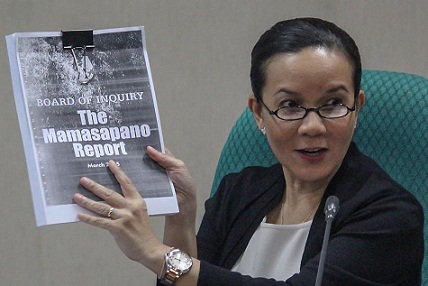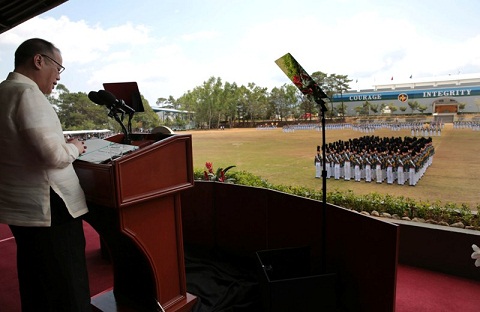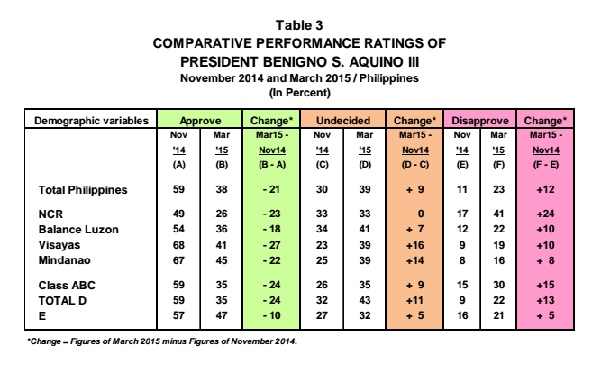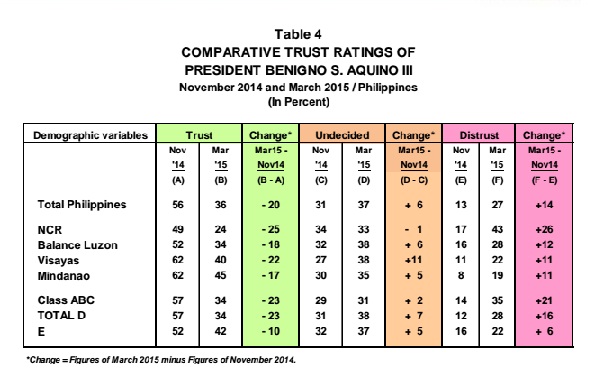But buck passage of BBL
By Julius D. Mariveles

President Benigno S. Aquino III presents the Operational Controlled Unit Officer of the Year Award to Maj. Lourdes Imperial during the 29th Founding Anniversary of the Presidential Security Group (PSG) at the PSG Grandstand, Malacañang Park in Manila City on Tuesday (March 10, 2015). This year’s celebration has for its theme: “Kalasag ng Pangulo: Kaagapay Tungo sa Pag-Unlad at Malawakang Pagbabago.” The PSG is the lead agency tasked in providing security to the President of the Philippines and the First Family, as well as visiting Heads of States and diplomats. (Photo by Gil Nartea / Malacañang Photo Bureau)
EVEN if they are not satisfied with his explanation on why the Mamasapano operation failed, most Filipinos want President Benigno S. Aquino III to stay in office amid calls by some sectors for his resignation following the botched operation that killed 44 members of the police Special Action Force (SAF), 18 members of the Moro Islamic Liberation Front (MILF) and five civilians.
In the latest Pulse Asia Ulat ng Bayan survey, 42 percent of the respondents disagreed that Aquino “should resign as President of the Philippines now.” Only 29 percent agreed that he should resign. However, majority of those surveyed – eight out of 10— also think that President Aquino’s explanation on the Mamasapano operation is not enough and that he should have attended the arrival honors for the fallen SAF troopers at the Villamor Airbase on January 29, 2015.
Too, 44 percent of the survey respondents said they don’t want Congress to pass the Bangsamoro Basic Law (BBL), a top priority legislation of the Aquino administration. Only 21 percent agreed that Congress should pass it while the remaining 36 percent were undecided. The proposed BBL would provide the framework for self-governance in the country’s Muslim south after a final peace agreement was signed between the Philippine government and the separatist MILF last year.
The survey also revealed that a great majority of Filipinos have heard, read or watched something about the BBL (88 percent) and virtually every Filipino knows about the Mamasapano incident (99 percent). Nine out of 10 Filipinos knew that Aquino failed to attend the January 29 arrival honors for the slain SAF troopers.
Ironically, more people in Mindanao are opposed to the passage of the BBL (62 percent), followed by those in the National Capital Region (52 percent), the Visayas (43 percent), and the rest of Luzon (32 percent). Sentiments for the passage of the BBL, on the other hand, was strongest in the balance of Luzon at 25 percent.
Opposition against the passage of the BBL was highest among the poor – economic Classes D and E – at 45 and 43 percent, respectively, with only 37 percent expressing opposition in Classes ABC.
Meanwhile, most people in the NCR (45 percent) and the rest of Luzon (47 percent) are opposed to the call for President Aquino’s resignation while only 39 percent of the people in Mindanao and 34 percent in the Visayas have the same sentiment.
The Mamasapano operation and related developments dominated the news headlines before and during the face-to-face interviews conducted by Pulse Asia from March 1 – 7, 2015.
These included:
- The declaration by President Benigno S. Aquino III of 30 January 2015 as National Day of Mourning for the fallen officers;
- The President’s absence during the arrival honors for the 42 of the 44 fallen policemen whose bodies arrived at the Villamor Air Base from Maguindanao on 29 January;
- President Aquino’s conferment of the Medalya ng Katapangan upon the 44 slain PNP-SAF policemen during the necrological services held as part of the National Day of Mourning;
- The conduct of several investigations to shed light on what really transpired in Mamasapano and who should be held accountable for the death of the 44 policemen;
- A proposal for the creation of a still another body – an independent truth commission – to conduct a probe into the incident;
- Amidst the unresolved questions surrounding the Mamasapano incident, calls for the resignation of President Aquino by several senior bishops belonging to the National Transformation Council (NTC), student groups and other militant organizations;
- The statement by the Catholic Bishops’ Conference of the Philippines (CBCP) that it is not supportive of such calls even as it favors the creation of a truth commission; and
- The expression by several business groups of their continued support for President Aquino and his administration’s peace initiatives in Mindanao despite the events in Mamasapano.
Other developments during this period that are connected to the Mamasapano encounter were:
- The removal of PNP-SAF Commander Getulio Napeñas who was removed from his post on 27 January 2015 following the death of 44 of his men during the Mamasapano encounter;
- The resignation of PNP Director General Alan Purisima on 05 February 2015 amidst reports that he was involved in the decision-making process related to the police operation in Mamasapano whilst under preventive suspension resulting from a graft and corruption charge;
- Reports that disgruntled members of the country’s armed forces are planning to stage a coup against President Aquino in the aftermath of the Mamasapano incident and expressions of loyalty to the Philippine government by high ranking military and police officers who say that they still have to verify such reports; and
- Military operations conducted toward the end of February 2015 by the AFP against the BIFF and the Abu Sayyaf in certain areas of Mindanao reportedly to reduce these groups’ ability to carry out violent attacks against civilians. The military offensive has resulted in casualties on both sides as well as the evacuation of thousands of civilians.



















